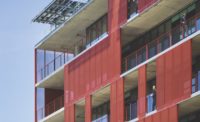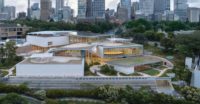The Fourth Factor: A Historical Perspective on Architecture and Medicine, by John Michael Currie. Washington, D.C.: The American Institute of Architects, 2007, 191 pages, $39.99.
The title of this book refers to the words of Hippocrates of Kos, widely regarded as the father of Western medicine. He held that there were “three factors” important to the success of medical care: the disease, the patient, and the physician. But here, author John Michael Currie, AIA, expands this list to acknowledge the role of the built environment in the healing process.

Illustrated with historical images that Currie has been collecting for almost three decades, The Fourth Factor tracks the relationship between the practice of medicine and architecture from ancient times to the present. It follows changing attitudes toward illness, advances in disease prevention, developments in technology, and the emergence of evidence-based design.
Sustainable Healthcare Architecture, by Robin Guenther and Gail Vittori. Hoboken, New Jersey: John Wiley & Sons, 2008, 448 pages, $75.
In Sustainable Healthcare Architecture, Robin Guenther, FAIA, and Gail Vittori, make the case for the urgent need to reinvent medical facilities so that they better promote the well-being of patients and staff, consume less energy and water, and produce less waste.
The book provides helpful background on tools such as LEED for Healthcare and the Green Guide for Healthcare, which the authors were instrumental in developing. In addition to informative text by Vittori, codirector of the nonprofit Center for Maximum Building Potential, in Austin, Texas, and Guenther, founding principal of the New York City–based Guentherfive Architects (now part of Perkins+Will), the book includes contributed essays on topics such as integrated design, the relationship between nature and healing, and commissioning.
Vittori and Guenther also demonstrate how to put environmentally sensitive strategies into practice with more than 50 health-care project case studies. Unfortunately, the book is largely in black and white, which does not fully convey the vibrancy of many of these buildings. But even if it is a bit graphically dry, Sustainable Healthcare Architecture is still an important reference for creating better places for healing.







Post a comment to this article
Report Abusive Comment